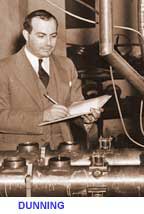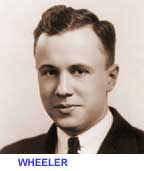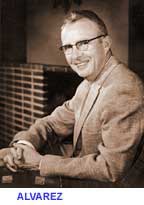Anderson and Fermi made a sort of agreement...
ANDERSON: I would teach him about Americanisms and he would teach me physics and I would lend him the apparatus and we would work together. Well, you know, things weren't very hard to do in those days. So he says, "Why don't we get the electrode of your ionization chamber, put some uranium on it, let's go down to the cyclotron, and let's see if we can see all this energy release." And so we got busy just that afternoon. But there was a meeting, a theoretical physics meeting in Washington, the next day. And Fermi was supposed to go to that. And so he left and I began to wonder what to do and I remembered that Dunning was in and I came to Dunning, and I said, "Why don't we see if we can see this fission?"
John Dunning was a physics professor who Anderson had been working with already. Dunning remembers...
 DUNNING: I went up to the 13th floor and brought down one of the old standard stand-by neutron sources, the radon plus berylium sources that had been used so much before. We put it next to the chamber containing the uranium and in considerable excitement we saw with even this very weak source about one big pulse, a huge pulse, on the oscilloscope every minute. The rate, however, was so slow that I had doubts whether this was really real or whether it was maybe a bad electrical contact. So we had another device, and installing that right next to the chamber, the rate went up according to my notes to something like seven or so with that device, huge pulses. We finally quit about 11 p.m. My notebook contains this phrase: "Believe we have observed new phenomenon of far reaching consequences."
DUNNING: I went up to the 13th floor and brought down one of the old standard stand-by neutron sources, the radon plus berylium sources that had been used so much before. We put it next to the chamber containing the uranium and in considerable excitement we saw with even this very weak source about one big pulse, a huge pulse, on the oscilloscope every minute. The rate, however, was so slow that I had doubts whether this was really real or whether it was maybe a bad electrical contact. So we had another device, and installing that right next to the chamber, the rate went up according to my notes to something like seven or so with that device, huge pulses. We finally quit about 11 p.m. My notebook contains this phrase: "Believe we have observed new phenomenon of far reaching consequences."
Meanwhile Bohr and Fermi went to the theoretical physics conference in Washington, DC. One physicist in close touch with Bohr was John Wheeler.
 WHEELER:
Bohr felt that he owed it as a responsibility to Frisch and Meitner that
word of their work-in-progress and their concepts should not really be released
until they had had the proper scientific opportunity to publish it. And
it was not until the second day of the conference that an issue of Die
Naturwissenschaften was handed to him which had just come in, which
had the work of Hahn and Strassmann; so then he could tell about it. And
then of course everybody got started on the experiments.
WHEELER:
Bohr felt that he owed it as a responsibility to Frisch and Meitner that
word of their work-in-progress and their concepts should not really be released
until they had had the proper scientific opportunity to publish it. And
it was not until the second day of the conference that an issue of Die
Naturwissenschaften was handed to him which had just come in, which
had the work of Hahn and Strassmann; so then he could tell about it. And
then of course everybody got started on the experiments.
Not only scientists, but also science reporters picked up the news. Across the continent in Berkeley, California, physics professor Luis Alvarez was particularly interested to hear of the discovery...
ALVAREZ: I remember exactly how I heard about it. I was sitting in the barber chair in Stevens Union having my hair cut, reading the Chronicle, and in the second section, buried away some place, was an  announcement that some German chemists had found that the uranium atom split into pieces when it was bombarded with neutrons—that's all there was to it. So I remember telling the barber to stop cutting my hair and I got right out of the barber chair and ran as fast as I could up to the Radiation Laboratory. And my student, Phil Abelson, had been working very hard to try and find out what transuranium elements were produced when neutrons hit uranium. And he was so close to discovering fission that it was almost pitiful. I mean, he would have been there, guaranteed, in another few weeks—when I arrived panting from the Student Union with my news about fission, and I played it kind of dramatically. I saw Phil there and I said, "Phil, I've got something to tell you but I want you to lie down first." So, he lay on the table (right alongside the control room of the cyclotron). "Phil, what you are looking for are not transuranium elements, but they are elements in the middle of the periodic table." I showed him what was in the Chronicle, and, of course, he was terribly depressed.
announcement that some German chemists had found that the uranium atom split into pieces when it was bombarded with neutrons—that's all there was to it. So I remember telling the barber to stop cutting my hair and I got right out of the barber chair and ran as fast as I could up to the Radiation Laboratory. And my student, Phil Abelson, had been working very hard to try and find out what transuranium elements were produced when neutrons hit uranium. And he was so close to discovering fission that it was almost pitiful. I mean, he would have been there, guaranteed, in another few weeks—when I arrived panting from the Student Union with my news about fission, and I played it kind of dramatically. I saw Phil there and I said, "Phil, I've got something to tell you but I want you to lie down first." So, he lay on the table (right alongside the control room of the cyclotron). "Phil, what you are looking for are not transuranium elements, but they are elements in the middle of the periodic table." I showed him what was in the Chronicle, and, of course, he was terribly depressed.
